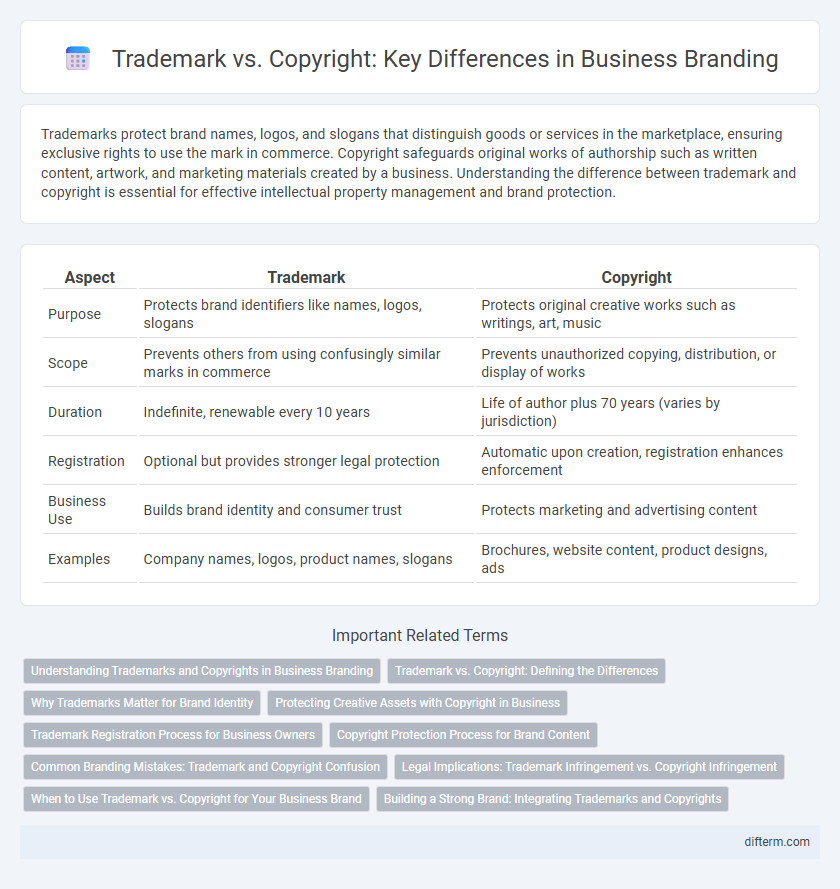Trademarks protect brand names, logos, and slogans that distinguish goods or services in the marketplace, ensuring exclusive rights to use the mark in commerce. Copyright safeguards original works of authorship such as written content, artwork, and marketing materials created by a business. Understanding the difference between trademark and copyright is essential for effective intellectual property management and brand protection.
Table of Comparison
| Aspect | Trademark | Copyright |
|---|---|---|
| Purpose | Protects brand identifiers like names, logos, slogans | Protects original creative works such as writings, art, music |
| Scope | Prevents others from using confusingly similar marks in commerce | Prevents unauthorized copying, distribution, or display of works |
| Duration | Indefinite, renewable every 10 years | Life of author plus 70 years (varies by jurisdiction) |
| Registration | Optional but provides stronger legal protection | Automatic upon creation, registration enhances enforcement |
| Business Use | Builds brand identity and consumer trust | Protects marketing and advertising content |
| Examples | Company names, logos, product names, slogans | Brochures, website content, product designs, ads |
Understanding Trademarks and Copyrights in Business Branding
Trademarks protect brand identifiers like logos, slogans, and names, ensuring exclusive use that distinguishes a business's products or services in the marketplace. Copyrights safeguard original creative works such as advertisements, packaging designs, and marketing content, preventing unauthorized reproduction or distribution. Understanding the distinct roles of trademarks and copyrights is essential for comprehensive business branding strategy and intellectual property protection.
Trademark vs. Copyright: Defining the Differences
Trademarks protect brand names, logos, and slogans that distinguish goods or services in the marketplace, ensuring exclusive use by the owner. Copyrights safeguard original works of authorship like written content, artwork, and software, granting creators exclusive rights to reproduce and distribute their work. Understanding these differences is crucial for businesses to effectively secure intellectual property and strengthen brand identity.
Why Trademarks Matter for Brand Identity
Trademarks protect distinctive brand elements such as logos, names, and slogans, ensuring exclusive rights that prevent competitors from causing consumer confusion. Effective trademark registration strengthens brand recognition, builds customer trust, and supports long-term market positioning. Unlike copyrights, which cover original works of authorship, trademarks focus specifically on identifiers that distinguish goods and services in the marketplace.
Protecting Creative Assets with Copyright in Business
Copyright protects original creative works such as logos, product designs, marketing materials, and written content, ensuring exclusive rights to reproduce, distribute, and display these assets in business branding. Unlike trademarks, which safeguard brand identifiers like names and symbols, copyright covers the artistic expression and creative content that differentiate a business's identity and marketing efforts. Securing copyright protection helps businesses prevent unauthorized use, maintain brand integrity, and leverage their creative assets for competitive advantage.
Trademark Registration Process for Business Owners
Trademark registration for business owners involves several key steps starting with a comprehensive search to ensure the desired trademark is unique and does not infringe on existing marks. The application process requires submitting detailed information about the business and the trademark, including the goods or services it will represent, to the relevant trademark office, such as the USPTO in the United States. After submission, the application undergoes examination, potential opposition, and finally registration, granting the business exclusive rights to use the mark for branding and legal protection.
Copyright Protection Process for Brand Content
The copyright protection process for brand content involves creating original works such as logos, marketing materials, and website content that automatically gain protection upon fixation in a tangible medium. Registering the copyright with the United States Copyright Office strengthens enforcement capabilities and provides legal evidence of ownership. This protection prevents unauthorized reproduction, distribution, and adaptation, helping businesses maintain exclusive rights to their creative assets and brand identity.
Common Branding Mistakes: Trademark and Copyright Confusion
Many businesses mistakenly use copyright protection for brand elements better suited for trademarks, such as logos and brand names, risking inadequate legal safeguards. Copyright protects original creative works like text and artwork, while trademarks protect symbols, phrases, and identifiers that distinguish goods or services in the marketplace. Confusing these protections can lead to brand vulnerability, potential infringement disputes, and loss of exclusive brand recognition.
Legal Implications: Trademark Infringement vs. Copyright Infringement
Trademark infringement involves unauthorized use of a brand's logo, name, or slogan, potentially causing consumer confusion and damage to brand reputation under the Lanham Act. Copyright infringement pertains to the unauthorized reproduction, distribution, or display of original works like marketing materials or business content, protected under the Copyright Act. Legal consequences for trademark infringement often include injunctions and damages related to brand dilution, while copyright infringement can result in statutory damages and fines for unauthorized copying or use of creative content.
When to Use Trademark vs. Copyright for Your Business Brand
Trademarks protect brand identifiers such as logos, slogans, and product names that distinguish goods or services in the marketplace, ensuring exclusive commercial use and preventing customer confusion. Copyrights safeguard original creative works like written content, artwork, and promotional materials, granting the business control over reproduction and distribution rights. Use trademarks to secure distinctive brand elements that signify source origin, and rely on copyrights to protect creative assets that express brand identity and marketing messages.
Building a Strong Brand: Integrating Trademarks and Copyrights
Building a strong brand requires integrating trademarks and copyrights to protect both brand identity and creative content. Trademarks secure logos, names, and slogans that distinguish products or services in the marketplace, while copyrights safeguard original works like advertising materials and website content. Combining these intellectual property rights ensures comprehensive protection, enhancing brand recognition and preventing infringement.
Trademark vs Copyright (business branding context) Infographic

 difterm.com
difterm.com